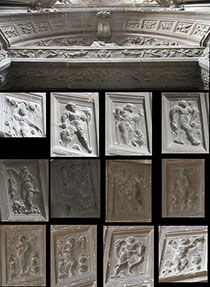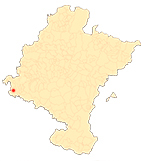Front façade of the parish church of Santa María de Viana
Astrological synastry with the horoscopes of Christ
One of the most curious iconographic elements of this doorway is the astrological synastry of the horoscopes of the birth and death of Christ, sculpted by Juan Ochoa de Arranotegui in the coffers of the intrados of the arch of the entrance door. This iconography, identified by Dr. Esteban Lorente, is based on Jerónimo Cardán's commentary on Cl. Ptolemy's Tetrabiblos, published in 1554. Thus, starting from the right side, and from bottom to top, following a counter-clockwise direction, we see various constellations represented in the twelve cassettes: 1st Pisces, as a child seated on a throne; 2nd Mars with the sun at his feet; 3rd the Moon in eclipse, as a woman with uncombed hair with a dragon at her feet; 4th Orion, as a warrior with shield and mace; 5th Milky Way as a nymph on the waters, in the form of a woman holding a vegetable garland and having her feet on the waters; 6th Gemini?, as a naked woman between cherubim and under her a female bust; 7th Saturn, as a giant with a staff in his hand and a skull at his feet; 8th Berenice, as a woman with a shaven head framed by an altar and a bonfire; 9th Virgo, as a woman with her right hand on her breast and her left hand pointing to the ground; 10th the Moon over the constellation of Hydra, represented as a woman stepping on the tail of the hydra, whose body has been lost, her head resting on a tree; 11th Ophiuchus, in which we see a muscular man fighting with two serpents; and 12th Aquarius, in the form of a child with two craters, Ganymede with the jugs of the temple of Jupiter, alluding to the astrological point called "The part of Fortune".
-
ESTEBAN LORENTE, J.F., "El arco de ingreso de la colegiata de Santa María de Viana. Horóscopo de Cristo", Berceo, 130, 1996, pp. 177-178.
-
ESTEBAN LORENTE, J.F., "Los dioses paganos en las iglesias españolas del siglo XVI", bulletin del Museo e high school Camón Aznar, LXXXII, Zaragoza, high school Camón Aznar, 2000, pp. 157-190.
-
FERNÁNDEZ GRACIA, R., (coord.), ECHEVERRIA GOÑI, P.L., and GARCÍA GAINZA, M. C., El arte del Renacimiento en Navarra, Pamplona, Gobierno de Navarra, 2005, pp. 111-114.
-
GARCÍA GAINZA, M. C., HEREDIA MORENO, M. C., RIVAS CARMONA, J. and ORBE SIVATTE, M., Catalog Monumental de Navarra. V. II**. Merindad de Estella, Pamplona, 1980, pp. 559-564.
-
GONZÁLEZ DE ZÁRATE, J. M., "Aproximaciones a la lectura iconográfica del programa mitológico en la portada de Santa María de Viana", Primer congress General de Historia de Navarra, anejo 11, Pamplona, Príncipe de Viana, 1988, pp. 179-196.
-
LABEAGA MENDIOLA, J.C., Viana monumental y artística, Pamplona, Príncipe de Viana, 1984, pp. 229-236.












